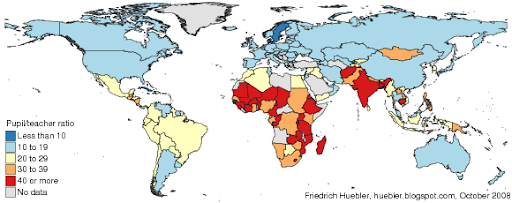The map below displays the pupil/teacher ratio in primary school in 194 countries and territories for which data were available. The data were obtained from the UNESCO Institute for Statistics. For 124 countries, the pupil/teacher ratios are from 2006, 12 countries have data from 2007, 42 countries have data from 2004 or 2005, and the remaining 16 countries have data from 1999 to 2003. For the map, all countries were divided into five groups:
- Fewer than 10 pupils per teacher: 7 countries
- 10 to 19 pupils per teacher: 90 countries
- 20 to 29 pupils per teacher: 43 countries
- 30 to 39 pupils per teacher: 27 countries
- 40 or more pupils per teacher: 27 countries

Data source: UNESCO Institute for Statistics, Data Centre, May 2008.
The lowest pupil/teacher ratios in primary school were observed in Tokelau (5.8), San Marino (6.3), Bermuda (8.3), Liechtenstein (8.4), Denmark (9.9), and Sweden and Cuba (10.0). Most developed countries, countries in Eastern Europe and former members states of the Soviet Union have pupil/teacher ratios between 10 and 19. Some countries in East and South-East Asia, the Middle East, Africa, and Latin America also belong to this group, among them China, the world's most populous country, with a pupil/teacher ratio of 18.3. The majority of countries in Latin America, as well as some countries in Africa and Asia, have pupil/teacher ratios between 20 and 29.
Pupil/teacher ratios above 30 are common in Sub-Saharan Africa and South Asia. In 11 countries, primary school teachers have more than 50 pupils on average: Afghanistan (83.4), Mozambique (67.4), Rwanda (65.9), Chad (63.2), Mali (55.6), Congo (54.8), Burundi (54.2), Tanzania (53.1), Zambia (51.2), Bangladesh (50.9), and Cambodia (50.4). 22 of the 27 countries with 40 or more pupils per teacher are located in Sub-Saharan Africa.
The following table lists the average pupil/teacher ratio in primary school by Millennium Development Goal region. The highest pupil/teacher ratios exist in Sub-Saharan Africa (40.7) and Southern Asia (37.8). In contrast, the average pupil/teacher ratio in the developed countries is 13.7. In Western Asia (17.8), the Commonwealth of Independent States (17.9), and Oceania (19.8), the average pupil/teacher ratio is also below 20. The global average is 24.6 pupils per teacher in primary school. All regional and global averages are not weighted the population of each country; instead, each country is given the same weight within its region, regardless of the size of its population.
Pupil/teacher ratio in primary school by MDG region, circa 2006
| MDG region | Pupil/teacher ratio |
| Developed countries | 13.7 |
| Commonwealth of Independent States | 17.9 |
| Eastern Asia | 23.4 |
| South-Eastern Asia | 26.5 |
| Oceania | 19.8 |
| Southern Asia | 37.8 |
| Western Asia | 17.8 |
| Northern Africa | 24.4 |
| Sub-Saharan Africa | 40.7 |
| Latin America and the Caribbean | 21.3 |
| World | 24.6 |
The data analyzed in this article can be downloaded from the UNESCO Institute for Statistics Data Centre, under Predefined Tables - Education - Table 11: Indicators on teaching staff at ISCED levels 0 to 3.
Related articles
- Pupil/teacher ratio in secondary school
- A view inside primary schools
- UNESCO releases data from 2007 education survey
- Universal primary education by 2015: A goal out of reach?
- Millennium Development Goal regions and UNICEF regions
- Millennium Development Goal 2: Universal primary education
- UNESCO Institute for Statistics Data Centre
Permanent URL: http://huebler.blogspot.com/2008/10/ptr.html
No comments:
Post a Comment